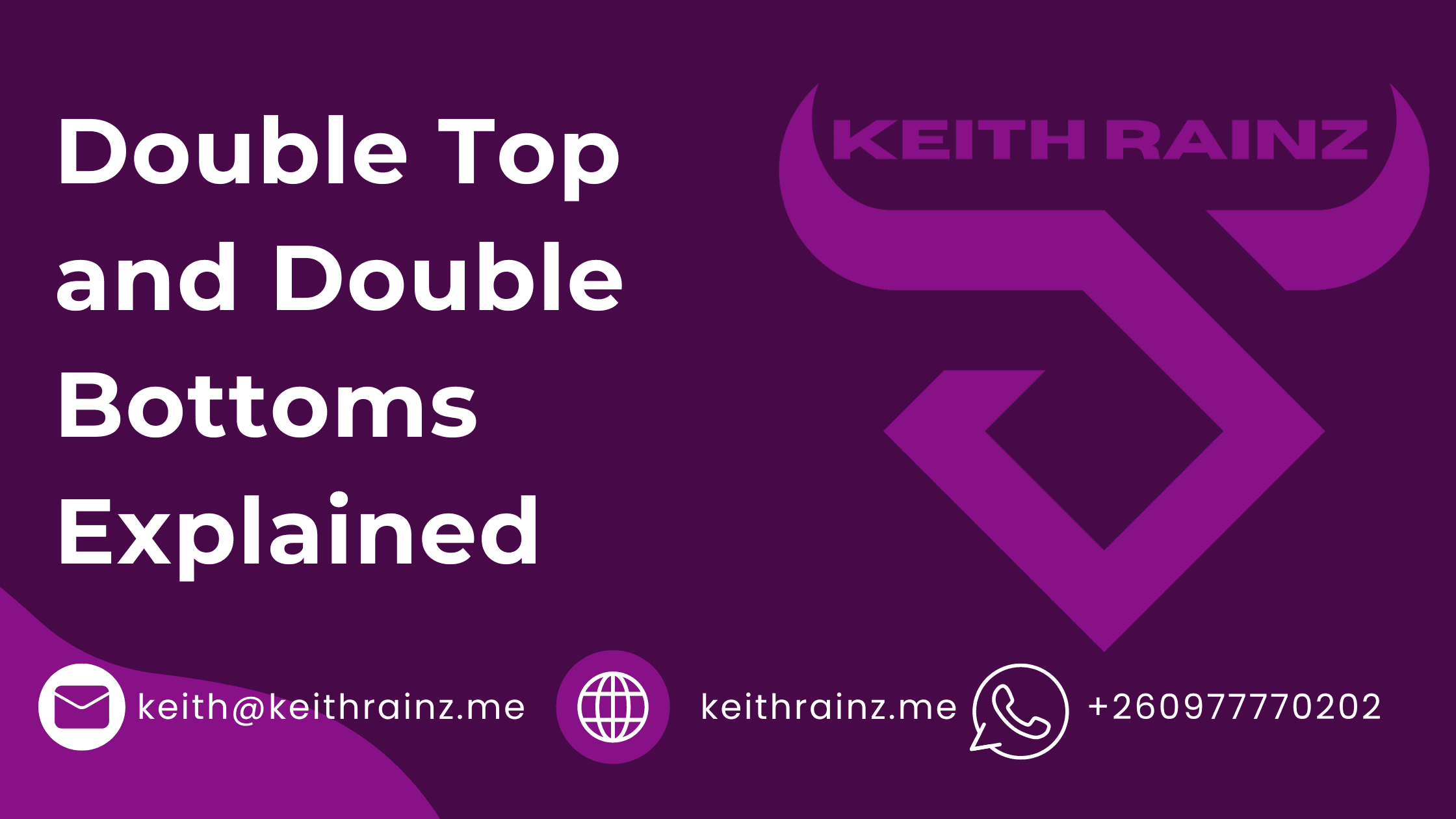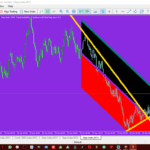When analysing a financial asset using technical analysis, there are many different chart patterns that are involved. The most important technical analysis technique is reading chart patterns. Comprehension the ideal entry and exit locations requires a strong understanding of this branch of technical analysis. Additionally, a significant component of these chart patterns is the double top and double bottom.
A trader can use double tops and bottoms to spot potential trend reversals in the price movement of an asset class. In-depth discussion of the double top and double bottom chart patterns and how they might be useful in trading will be covered in this article.
What exactly are double top and bottom?
The terms “double top” and “double bottom” describe chart patterns that move like the letters “M” (double top) or “W” (double bottom) (Double bottom). Both can be utilised to implement a trading strategy because they are examples of recurrent patterns. While the double bottom pattern is a sign of bullish price movements, the double top pattern indicates a bearish reversal in trend direction.
When using these price action patterns, traders aim to trade back lower with the double top or back higher with the double bottom. The double top and bottom pattern is simple to spot, but when traded properly, it has the potential to be very powerful. A double bottom is a design in which two bottoms appear, and a double top is a pattern in which two tops appear.
While it is relatively easy to identify this pattern once you do, there are a number of strategies you may employ to trade it and find higher-reward transactions. The double bottom has the same four crucial characteristics as the double top, with the exception that we search for an upward price reversal rather than a downward one. The double bottom has two support rejections, while the double top has two rejections of resistance.
The double bottom and double top stand for what?
The double top pattern, when complete, predicts a bearish reversal because there are two pieces of adverse evidence. The first is that the price runs into opposition at the chart’s highs, making it impossible for it to move past the initial high on subsequent attempts. A new swing low is then formed when the price breaks below the prior swing low. Instead of indicating an increasing trend, these are symptoms of a negative trend. Downtrends produce lower swing lows, which are necessary for a double top pattern.
The double bottom denotes a bullish reversal because there are two pieces of encouraging evidence. In the chart above, the price reaches support, and although trying twice, it is unable to make a lower bottom. After then, the price increases above the old swing high, creating a new swing high. Find out more about the market’s impact on the bearish and bullish markets.
recognising the double bottom pattern
A double bottom is formed as the first indication of a potential reversal in the chart pattern known as the rounded bottom pattern. The rounded bottom pattern is typically visible to traders near the conclusion of an extended negative trend. In order to recognise the double bottom pattern, it is crucial to be aware of the trend reversal. By correctly identifying this pattern, investors can profit greatly from bullish trends because double bottoms typically signal a positive turnaround.
The double bottom is shown by the two lows below the resistance level. The neckline refers to the point of resistance. When prices cross the neckline or resistance level, the bullish trend has reversed, and traders can start long positions. After the bearish trend and a return to the neckline, the first low occurs.
After recovering to its neckline, the price turns bearish and drops to form the second low. The pattern is finished when the prices return to the neckline after creating the second low. Once the second low has been made, the price movement must be bullish.
The bullish trend is considered established when it crosses through the neckline level and moves higher. Many traders will attempt to open a long position at the second low.
recognising the double top pattern
A double top is a negative reversal trading pattern. Two peaks that climb over a support level make up the neckline. The initial high will occur after a significant bullish trend, then there will be a regression to the neckline. The momentum will switch back to bullish at this point, creating the second peak.
Double peaks are rare, but when they appear, it typically indicates that investors are seeking out the last of a strong trend’s profits. Double tops typically indicate a downward turn, allowing traders to make money by offloading the stock while it is falling. The pattern is finished when the prices return to the neckline after the formation of the second peak.
This pattern is made up of two peaks rising over a neckline support level. The initial high is created after a significant climb, and it is then followed by a regression back to the neckline. After recovering to its neckline, the price turns bullish and advances to form the second high. When prices cross over the neckline or support level, the bearish trend has reversed.
For the double top pattern to be confirmed, the trend must retrace more than it did after the initial pullback following the first peak. This typically denotes that the neckline support level has been breached by the price momentum. Additionally, a lengthy bearish trend is predicted.
indication with a double top and bottom
Numerous combinations of price action patterns and indicators are possible. Double tops and bottoms can be traded directly by examining the price action of the pattern, but they can also be used in conjunction with technical indicators to provide additional confirmation and strategy.
An early entry point into a double bottom or top trade could be provided by, for instance, the relative strength index (RSI) rising above a predetermined level from below or the stochastic oscillator crossing its signal line.
These trade indications emerge before the price action signals when the price rises over a swing high. This offers a fresh viewpoint on the possibility of trading these patterns.
How are double top and bottom traded?
After a protracted uptrend, a double top is a reversal pattern that develops. You would check for historical support and resistance levels to aid in determining the target price. The price peaks at the tops when it reaches a resistance level that it can’t overcome.
Trading double top and bottom patterns can be done using a variety of strategies. A double top pattern may indicate a trend reversal to a trader, while a double bottom pattern may indicate the beginning of a bullish trend. They might then begin looking for short or long positions, depending on their overall trading strategy.
For a double top pattern, some traders may place a stop-loss order above the second high, which is a resistance level. Others might place their stop-loss above a recent swing high or use a trailing stop-loss. After briefly reaching this level, the price will move away from it before coming back to test it once more. You have a double top if the asset price retraces back to that level once more.
Many traders determine their profit target by deducting the height of the pattern from the breakout point to the swing low. For the double bottom pattern, some traders would place their stop-loss below the second low, while others may use a trailing stop-loss or place it below a more recent swing low. When a price crosses a line, you can typically anticipate that it will move just as far the other way as it did in the trend’s initial direction.
The procedure in detail for trading double tops and double bottoms
The two tops form after a strong surge up. Observe how the second top was unable to surpass the height of the first top. This shows that the purchasing pressure is almost gone, which is a strong sign that a reversal is imminent. We would place our entry order below the neckline of the double top since we anticipate a reversal of the uptrend.
Although the double bottom is also a trend reversal pattern, this time we’re looking to buy rather than sell. These structures appear when two valleys or bottoms have grown after a protracted downturn. In the same manner that other reversal patterns are identified, price objectives can be too.
By calculating how far the peaks are from the trendline and applying that measurement to the opposite side of the trendline, you may determine the ideal minimum price level. After breaking through the neckline, the price increased significantly. Keep in mind that double bottoms and double tops are patterns that indicate a change in trend. Keep an eye out for them after a significant decline.
Keep in mind how the second bottom fell short of significantly breaking the first. This suggests that the selling pressure will ease and that a turn around is imminent. Because it was unable to go below a certain level, as can be seen in the chart above, the price produced two valleys after the last drop. Learn more about the charts and trading patterns.
What exactly are triple tops and bottoms?
Triple tops and bottoms and double tops and bottoms form somewhat differently. The bottoming pattern consists of three bottoms separated by two rallies, while the topping pattern has three peaks at comparable price levels. The pattern is finished when the price moves above the rally highs or below the retreat lows.
In order to provide the trader with the same information, triple tops and bottoms are traded similarly to double tops and bottoms. They typically point to a shift in the trend’s direction.
In conclusion, there is a double top and bottom.
The double top and double bottom patterns are additional tools in your price action trading toolbox. Like with any pattern, you should practise a lot and make sure the strategy you chose fits your trading style. Avoid using a more assertive approach if you enjoy confirmation.
With the aid of technical analysis and the many tools that PrimeFin offers, you can easily keep track of your position. The broker offers access to chart patterns so that you may read double tops and bottoms to determine the best points for entrance and exit.
I suggest using the double top and double bottom patterns with your existing trading strategies. Even while it’s a good tool for spotting market reversals, it’s just one pattern. You may increase your odds of generating good trades by using a variety of other strategies, including as adding price action triggers, spotting trends, keeping an eye on recent momentum, and making use of the complete price action story.







